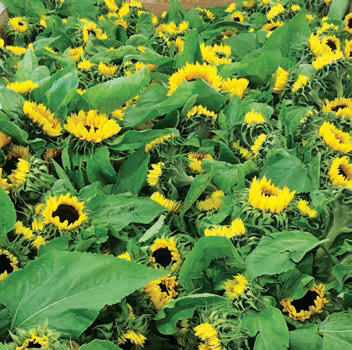Andy Whelton from the Teagasc Horticulture Development Unit explores the growth of this popular annual for sale as mono-bunch, cut flowers or as a farm feature to a horticultural business.
The annual sunflower, Helianthus annuus, is native to North America and has a long history
as a source of medicine, food, oil and dye. We are familiar with it as a popular cut flower sold in mono-bunches or as an eye-catching centrepiece in mixed bunches. Sunflowers are a summer-grown field crop but also grow well under protection; tunnel-grown flowers offer a longer season due to increased protection from wind and rain damage. Sunflowers can be an attractive product offering in a variety of businesses. They can be sold alongside a range of other products and if the potentially long flowering season is exploited, the selling
season can stretch well into autumn, to coincide with pumpkins in the run up to Halloween. The phenomenon of Instagram ‘moments’ with flower fields as the backdrop can be an additional attraction for open farms and mixed horticultural businesses.
Site and Soil
When grown outdoors, a sheltered south facing site is desirable which warms up rapidly in the spring. Sunflowers are deep rooted and have specific water and nutrient needs although they can be grown in a wide range of soil types.
Scheduling
Sunflower planting can be worked into a variety of schedules to suit different marketing models. Sunflowers planted at the end of April are likely to start flowering from mid-July if conditions are favourable or in early August for larger headed varieties. Successive harvests of flowers can be achieved by new plantings every 7 – 14 days during the spring. Plants sown at the start of April will be ready for harvest in 14-17 weeks depending on
cultivar and conditions and will be ready for harvest between mid-August and early September. Crops grown under protection will mature a lot faster.
Cultivars
A wide range of sunflower cultivars are available, offering different head sizes and growth
habits. Cultivars will either produce a single head (grandiflora) or multiple heads on a single plant (multiflora). The colour palette now available for sunflower cultivars is broad and covers the spectrum from cream to bright orange to dark amber. In Ireland, the
main seed suppliers for the specialist cut flower species, are Takki seeds (www.takiiseed.com), Evanthia (www.evanthia.nl), and Johnny seeds (www.johnnyseeds.com). Proveg seeds (www.provegseeds.com) have been developing the Galilee series which particularly suit the Irish climate.
Cultivation
For the outdoor summer crop, most cultivars can be grown in the field between late spring and early winter. Seed can be sown directly into the soil when temperatures reach at least 6-8°C. Seed should be sown to a depth of 2-5cm and to a greater depth if the soil is dry. The optimum density is on average approximately 10 seeds/m2. A spacing of 20–30 cm between plants is generally used for standard cultivars but a wider spacing of 50 cm and above can be used for larger multi-head cultivars. Planting at higher densities generally reduces head size. Good seedbed preparation is essential with a fine firm texture. For large areas, cereal or precision drills can be used (e.g. disk, belt or pneumatic) but accuracy of drilling is essential as the crop will not expand to fill gaps.
For early or late season cut flowers, sunflowers can be grown to maturity in tunnels. Compact cultivars are more suitable for tunnel growing as flowers grown in tunnels will be taller. For earlier production, seed can also be sown in modular trays for germination and
transplanting from late March onwards. The germinating seeds should be kept warm (24°C) and will be ready for transplanting 3–4 weeks after sowing, once the second true leaf has been formed. Sunflower plants can also be pot grown and the restricted rooting volume can help to reduce cropping times but the plants will require careful feeding and irrigation. Sunflowers are not normally supported although some growers find a layer of mesh useful when grown under protection.
 Crop Nutrition
Crop Nutrition
The deep roots of sunflower plants can access nitrogen deep in the soil so acceptable yields can be achieved from relatively low nitrogen soils without fertilisation. High soil nitrogen can reduce yield by encouraging vegetative growth so caution is advised when using fertiliser. A low level of phosphorus and a relatively high level of potassium is required to promote flowering. A maintenance application of phosphate and potassium of 40–60 kg/ha is recommended to maintain at required levels.
Growth of sunflowers in highly acidic soils (below pH 5.0) puts the crop at risk of micronutrient deficiencies, especially deficiencies of molybdenum, copper and manganese. Growth in calcareous or sandy soils can also present a significant risk of boron deficiency. It is sensible to undertake a soil analysis prior to sowing or planting sunflowers and Teagasc can then provide tailored recommendations for growing.
Weeds
There are few herbicides approved for sunflower planting so weed control after establishment can be difficult. An overwinter fallow period of growing areas, before planting, can be useful in controlling grass and broadleaf weeds using non-selective herbicides. Once the sunflower crop is established the broad canopy and tall height will out compete the majority of weeds. However, the crop is susceptible to weed competition during early establishment; from as early as the fourth week post-emergence. Stomp Aqua
(pendimethalin) has off label approval and can be used before emergence.
Stratos Ultra (cycloxydim) has off label approval for grass weeds in the crop prior to stem elongation. Mechanical weed control can also be very effective, given the wide row spacing
recommended for sunflower planting.
Pests & Diseases
Sunflower plants are vulnerable to a range of pests and diseases. During early establishment slugs can be a particular issue. In field crops, larger pests (pigeons & rabbits) can be a problem during establishment and ripening. Some insect pests may
cause minor damage (e.g. tortrix larvae, leaf miners and thrips), however there are few
control options available and these insect pests are unlikely to be a significant impediment
to growth.
The fungus Botrytis can infect sunflower plants and cause head rot. Infection is common when the crop is grown in damp, cool (15-25 °C) conditions. Botrytis will discolour the back of the head and spread to the petals. Petal spotting can also be an issue, the cause of which remains unclear, however the resulting spots or blemishes can become brown and
necrotic and be serious enough to render stems virtually unsaleable.
Harvest
While sunflowers are relatively more robust than other cut flowers, care must be taken during the picking and selling processes. Additional storage space, transport space and labour is needed to handle the crop compared with other crops. Cut stems need to be put into water immediately after picking to avoid rapid wilting. On a small scale, irrigation shortly before picking can improve shelf life after harvest. Recommendations on cutting
schedules can vary from cutting when the ray florets (long, straplike petals along
the outside of the sunflower) are barely visible to cutting when almost completely open. A useful middle ground is to pick when the ray florets are between half and fully expanded, usually when the petals are perpendicular to the flower head. If picked when the ray florets are too tight and stored cool, the sunflowers may not open properly. Stems with blemishes or spotting on the flower heads are unlikely to be acceptable. Remove all but three to four leaves as additional leaves reduce shelf life significantly. Cut stems can be kept for up to a week in a cold store. A shelf life of up to two weeks can be achieved by using suitable flower foods such as Chrysal CVBN (sodium dichloros-triazinetrione, hydrated).
Some pictures courtesy of Lyndon Mason Cut Flower Centre, Lincs, UK. ✽
  ornamental cut foliage crops in the Teagasc Horticultural Development Unit, continues his series of articles on the agronomy and screening work on innovative novel plant material being trialled for use in the floristry trade at Kildalton Agriculture and Horticultural College, Pilltown for use in the floristry trade. Contact Andy Whelton: andy.whelton@teagasc.ie |










